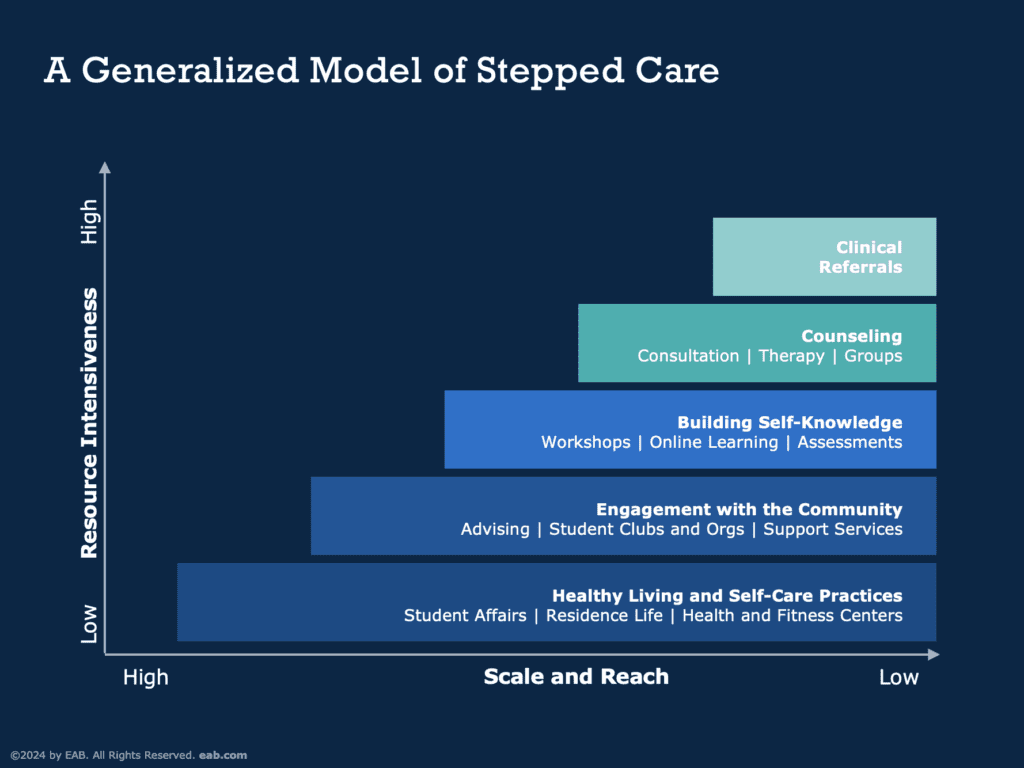4 ways to bridge the gap in your student mental health services
The student mental health crisis shows no signs of slowing, but colleges don’t have to go it alone. Technology-enabled solutions can help extend support capacity at all levels.
For a recent episode of “Office Hours with EAB,” I sat down with Dr. Nathaan Demers, a student mental health expert from Mantra Health, and Dr. Joe Cooper, Vice Provost for Student Success and Dean of Students at Montana Technical University to discuss solutions for supporting the “whole student.” Below are the takeaways from our conversation, including four tips for leaders who want to improve and extend their mental health services without hiring more counselors.
Listen to the podcast where we discuss how to improve student access to mental health services
The stats are sobering
60% of students now meet the criteria for at least one mental health condition, a 50% spike from just a decade ago. An alarming 81% of students report their mental health has negatively impacted their academic performance over the past month alone, according to this survey by Healthy Minds.
Widespread student wellbeing challenges can no longer be ignored or treated as just the job of the counseling center to solve. Students are bringing their “whole selves” to campus — with all the complicated emotions, struggles, and real mental health needs that entails. If institutions want to provide a truly supportive learning environment, they must take a multidimensional approach to mental health promotion and care.
Challenges in meeting student mental health needs
With budgets constrained and a national shortage of licensed clinicians, most colleges simply don’t have the staffing resources to provide enough in-person counseling support to meet this surging demand. Dr. Joe Cooper of Montana Tech University points out the unfortunate reality that many students brave enough to reach out for care often face weeks-long waitlists to get an appointment — leading too many vulnerable students to slip through the cracks.
“If we miss them in those moments when they’re ready to get help, we might ultimately never be able to serve them,” explained Dr. Nathaan Demers. “The therapeutic window is often incredibly small.”
Colleges cannot hire their way out of this crisis using traditional in-person counseling center staffing alone. As Dr. Cooper emphasized, student mental health can no longer be treated as just the responsibility of these overstretched clinicians. A broader, public health-inspired “stepped care” approach is required to make resources more holistically accessible across different levels of student need.
4 tech-enabled ways to bridge the gaps in student mental health services
Technology plays a pivotal role in simplifying stepped care, offering a scalable and efficient means of delivering support across various levels of need. By leveraging digital platforms, colleges can seamlessly integrate universal prevention strategies, early intervention measures, and access to professional care.
Mental health and wellness strategy extends beyond counseling

- Prevention Through Smart Outreach
At the universal prevention level, colleges can leverage technology like automated messaging campaigns and self-guided online content to build mental health literacy and promote positive coping skills for the entire student body. Student success platforms like Navigate360 allow schools to share bite-sized self-care resources like meditation videos, grounding exercises, healthy habit tips and more with just a few clicks. Embedding this small, relatable mental health content where students already spend time online helps normalize self-care and primes an ongoing dialogue around prioritizing wellbeing between more acute clinical care interventions. - Early Intervention
For students showing signs of distress, embedding self-assessments and AI-guided triage tools into the same apps provides an easy way to get customized guidance on appropriate support resources before issues escalate. A student whose results indicate they are struggling with loneliness and lack of motivation could immediately get enrolled in a peer support group facilitated by trained students. - Expanding Access
When professional care is needed, technology helps bridge major access gaps that students too often face. Mantra Health’s mental health and wellness solution integrated directly into Navigate360 enables students to connect with a licensed counselor for a secure virtual session — no more waiting weeks for an appointment. This “anytime, anywhere” access catches students in their moment of need. - Seamless Safety Net
Perhaps most critically, centralized technology platforms make it possible to provide seamless 24/7 crisis support so no student ever has to struggle alone on their darkest days. Digital crisis lines, counselor “warm handoffs,” and access to emergency resources can be made available everywhere via the Navigate360 student app.
Learn how to build your own stepped care model
Building a sustainable solution
EAB is working with Mantra Health as its Strategic Mental Health and Wellness Partner to expand the availability of these hybrid wellness services by embedding access to them directly within Navigate360 and Starfish, apps that more than 10 million college students already use to improve their college experience. This unified platform exponentially scales support capacity and accessibility in a cost-effective way amidst workforce constraints.
As Dr. Demers summarized: “There is no one-size-fits-all solution to mental health. Students come to campus from a variety of mental health needs and lived experiences, so improving the inclusivity and accessibility of support is critical.” By ensuring that holistic wellbeing resources are readily accessible wherever students are, institutions can address this increasingly urgent issue more effectively.

More Blogs

Four signs it’s time to break up with your student CRM

Three lessons from 1,200 student success leaders on higher ed’s future
